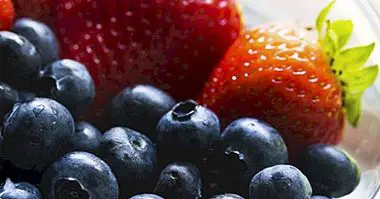Chlorophyll: characteristics and beneficial properties of this pigment
When we observe the great diversity of life that surrounds us, it can be difficult to imagine how something so beautiful and complex can depend so much on elements that seem so simple and habitual as water, sunlight or the oxygen we breathe. However, the truth is that without these elements life as we know it on our planet would not be possible. One of the previously mentioned elements, oxygen, would not exist to such a large extent in nature if it were not for the emergence and evolution of a small pigment present in plants: chlorophyll .
This pigment is a vital component for the plant because it allows it to survive, and for us because in large part thanks to it is the photosynthesis that has contributed to enrich our world of oxygen we need to survive. And not only that: several studies seem to indicate that chlorophyll, when added to our diet, can also have interesting beneficial properties for our health. Throughout this article we will see a brief comment on some of these aspects.
- Related article: "The 27 best medicinal plants, their effects and contraindications"
What is chlorophyll?
It receives the name of chlorophyll to one of the most relevant types of molecules for the vegetable kingdom, being a capital pigment because it is only thanks to this element that vegetables can perform photosynthesis , something fundamental for their survival. And not only for the plants themselves but also for all that creature that needs oxygen to survive (including us), since photosynthesis is what generates most of the oxygen we breathe.
Chlorophyll is found in the chloroplasts of different types of plants and algae , being the main responsible for the greenish coloration that we capture in these beings. Also, it is also possible to find it in some bacteria.
Chlorophyll molecules are composed of a ring of proteins called porphyrin, which contains magnesium and is the main responsible for it can capture sunlight, and in turn a phytol chain (an alcohol) that keeps it in the membrane and that presents a hydrophobic performance. Its structure recalls and is very similar to that of animal hemoglobin , although as we have said the main component of its core is magnesium (instead of the own iron of the animals).
In fact, although we usually think of chlorophyll as something homogeneous, the truth is that we can find different types of chlorophyll, specifically the chlorophylls a, b, c (most common of algae), dyf (these last two more typical of bacteria) . of which mainly chlorophyll a and chlorophyll b (which are what give the green color to plants) stand out.
- Maybe you're interested: "The 4 differences between the animal and the plant cell"
How does it work in plants?
The role of chlorophyll itself is to absorb sunlight and transmit it to the reaction center, in a complex photosystem in which elements such as chlorophyll a (which is the only type of chlorophyll that transforms light energy into chemical energy) which has contribute to generate energy and organic matter, as well as oxygen.
The operation of chlorophyll is as follows: the capture by the molecule of a photon of light will make the electrons that are part of it enter a much more energetic and excited state, which can only remain in that state a brief amount of time before transferring the excess energy to another molecule (a transmission that can end up generating the something that as it happens is causing the energy to end up reaching the parts of the cell that perform photosynthesis), dissipating it in the form of heat or emitting by itself what is commonly known as fluorescence.
Properties and uses in humans
Chlorophyll is a fundamental substance for the survival of plants, since it allows them to take advantage of the light of the single to make photosynthesis and generate organic matter, nutrients and energy for the plant itself from carbon dioxide. But the truth is that this pigment is not only beneficial for plants , but that several studies suggest (albeit with different results) that it has a series of interesting properties useful for the human being. Among the properties that are most often cited despite the fact that the data is not totally clear, the following stand out.
1. Depurative
One of the best known properties of chlorophyll is the fact that it facilitates a good gastrointestinal health, favoring the evacuation and motility of the digestive tube as well as helping to protect the intestinal flora. Also, also seems to facilitate the expulsion of heavy elements and toxic potential .
two.Antioxidant and healing
Another interesting properties of this substance is its high antioxidant content, which favors the fight against free radicals and helps to prevent cell damage and aging. In this sense, it is also used in anti-aging products. In addition to it it is usual its use in wound healing , which seems to facilitate.
3. Anti-inflammatory
Different studies seem to indicate that in addition to being an antioxidant, chlorophyll contributes to reducing proinflammatory cytokines and to a certain extent diminishing the effects of inflammation. In this sense it can help treat intestinal inflammations or arthritis.
4. Contributes to good circulation
Another property attributed to chlorophyll (although it is disputed whether it is real or a myth), partly thanks to its antioxidant, depurative and anti-inflammatory potential , is to promote the proper functioning of blood circulation.
It is said that its magnesium content helps to increase production and improve the health of red blood cells, which in turn favors the oxygenation of the body. Although there is doubt about the latter, if there appears to be a little more consensus on the fact that it contributes to reducing cholesterol and triglycerides, something that undoubtedly favors circulation and cardiovascular health and reduces the likelihood of problems in that system. It also seems to help to alkalize the blood.
5. It favors the coagulation
In addition to the above, this pigment is rich in vitamin K, a substance that participates in the blood can coagulate and helps control possible bleeding . This also includes that of menstruation, which helps control.
6. Reduce odor
As we can observe with some ease in a large number of body hygiene products, chlorophyll is often used as a component to make deodorants or even mouth rinses or sprays . This is because it is considered that it has the property of reducing bad body odor, either by combating bad breath or the smell of sweat. It also seems to reduce the bad smell of urine and feces.
Bibliographic references:
- Chermonosky, S .; Segelman, A. & Porets, R. (1999). Effect of dietary chlorophyll derivatives on mutagenesis and tumor cell growth. Teratogen Carcinogen Mutagen. 19: 313-322.
- Manrique, E. (2003). Photosynthetic pigments, something more than the capture of light. Ecosystems, Year XII (1). [On-line]. Available at: http // www.aeet.org / ecosystems / 031 / informe4.htm
- Subramoniam, A., Asha, V.V., Nair, S.A., Sasidharan, S.P., Sureshkumar, P.K., Rajendran, K.N., Karunagaran, D. & Ramalingam, K. (2012). Chlorophyll Revisited: Anti-inflammatory Activities of Chlorophyll a and Inhibition of Expression of TNF-α Gene by the Same. Inflammation, 35 (3): 959-966.



















